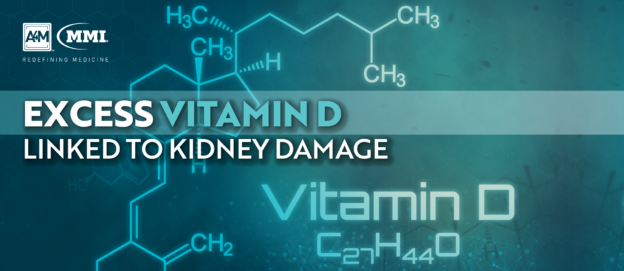Used for its wide-ranging purported benefits from reducing cancer risk to maintaining healthy bones and teeth, vitamin D is readily available to the public in the form of supplements and over-the-counter formulations. Declared a global epidemic in 2010, vitamin D deficiency continues to affect billions of individuals worldwide. However, new research indicates the potential toxicity of excess amounts of vitamin D. The common perception that consuming increased amounts of the vitamin can only lead to added benefits may be wrong, as recent evidence reveals it can actually lead to increased harm on the body, specifically kidney failure.
A 2019 case study published in the Canadian Medical Association Journal, details the potential noxious effects of excessive vitamin D consumption in a 54-year-old man. Lead author Dr. Bourne Auguste, a clinical fellow in Home Dialysis at Toronto General Hospital, reports the case of a man who returned from a trip to Southeast Asia with significantly elevated creatinine levels, signifying impaired kidney function. Potential causes included the patient’s anti-hypertensive medication and diuretics, which were immediately discontinued. Four weeks later, creatinine levels were at an all-time high. The patient was referred to a nephrologist, who concluded the man had hypercalcemia, elevated levels of vitamin D, and kidney damage.
Supplements and Sunlight
The above complications were tied to high doses of vitamin D prescribed to the patient by a naturopath, despite no known history of deficiency or bone loss. In addition to consuming between 8,000 and 12,000 IU of vitamin D for 2.5 years, the patient had spent extended periods of time in the sun, averaging between 6 to 8 hours per day for 2 weeks in Asia. He was advised to stop consuming vitamin D supplements and calcium-rich foods however, at the following visit, physicians found continuously increasing levels of 1,25-dihydroxyvitamin D and calcium. New-onset itchiness, likely due to the patient’s hypercalcemia, was also reported.
Adjunctive therapies alongside the cessation of vitamin D supplements, such as hydroxychloroquine and glucocorticoids, have been shown to reduce levels of 1,25-dihydroxyvitamin D in the body. The patient was prescribed 400 mg of hydroxychloroquine daily, which decreased his levels of calcium and vitamin D. During a follow-up one year later, the patient’s calcium and vitamin D levels had returned to normal, but he suffered from stage 3B chronic kidney disease.
Vitamin D Guidelines
Revealing the link between excessive vitamin D consumption and kidney damage in non-deficient individuals, this case study aims to inform a wider audience of the potential noxious effects of large doses in patients with normal serum vitamin D levels. Although rare in occurrence, consumption of over 10,000 IU daily can lead to toxicity, also called hypervitaminosis D. 2010 Canadian guidelines from Osteoporosis recommend 400-1,000 IU of vitamin D daily for most individuals and between 800 and 2,000 IU daily for older adults facing an increased risk of osteoporosis. In the U.S., National Institutes of Health recommends 600 IU daily for males and females between the ages of 1 and 70, and 800 IU per day for those older than 70.
Toxicity and Management
Due to its wide therapeutic range, vitamin D toxicity is rare. However, as it is a fat-soluble vitamin, high doses taken over extended periods of time can eventually lead to buildup and long-term complications such as kidney function impairment.
Vitamin D toxicity can often go long undetected due to its vague presentation. The non-specific symptoms include fatigue, high blood pressure, frequent urination, confusion, and itchiness. Additionally, patients may be taking supplements without full disclosure to physicians. Early detection of toxicity may help prevent hypercalcemia and kidney damage.
A review of prescription and over-the-counter medications should be conducted in patients with suspected hypervitaminosis D. Management of the condition also includes limiting exposure to sunlight and regular monitoring of vitamin D levels, even in asymptomatic patients. Due to its fat solubility, vitamin D at increased levels may be present in the body for several months after cessation.
Although vitamin D toxicity is rare, clinicians should be aware of the risks of overconsumption and the potential long-term complications associated with it. Further research needs to be conducted to determine the risks of vitamin D supplements and overconsumption in the non-deficient population.

